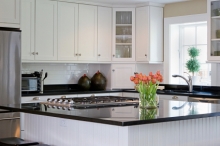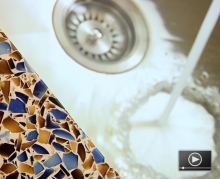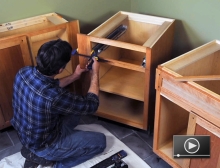Choosing Green Materials for Kitchen Remodeling
Video
The kitchen is one of the most expensive parts of the house to remodel – they contain a good deal of specialty equipment and many major appliances. The fundamental concepts behind green building also apply to remodeling: energy efficiency, indoor environmental quality, and renewable or sustainable materials.
The range of green materials and products available on the market is broad, so products to suit every kitchen remodeling project can be found, even if very strict guidelines of green building are to be followed. Below we examine countertops and appliances, two of the items most commonly updated or changed out during a kitchen remodel.
Green Kitchen Countertops
What qualifies building materials as green? This answer will vary among individuals, and different materials have different sources, methods of manufacture, life cycles, and other factors. The trade-offs largely come down to which characteristics matter more to the individual consumer. Which green principles an individual feels are more important can drive the decision in one direction or another. For example, it is difficult for a single product to be made from natural materials and also have recycled content. In some instances, too, transportation costs can make an otherwise green material choice unsustainable: where the project is located and where the material comes from can be a deciding factor, as with the Regional Materials credit in LEED for New Construction and Major Renovations, for example. LEED defines Regional Materials as materials or products that have been extracted, harvested, or recovered – as well as manufactured – within 500 miles of the project site.
Consumers who want natural materials with minimal processing will tend to prefer options such as wood or natural stone (granite, soapstone, and the like). On the other hand, composites frequently have high recycled content. Epoxy-based synthetic materials generally require the least owner maintenance.
Wood requires additional care and maintenance, compared with many other countertop materials. Wood shows wear over time more than many other materials, but the authentic character and feel of natural wood appeal to some. For countertops, butcher block is likely to stand up to kitchen use far better than simple boards. Butcher block counters can also make use of small wood offcuts that might otherwise be lost as scrap, adding to its green qualifications.
Granite is a long-lasting and durable material. It needs a little maintenance, but should last for years and years without any significant degradation. The biggest drawback to granite is that it often comes from overseas quarries, increasing the carbon footprint involved in shipping the material.
Other types of stone are also green choices. Soapstone, bluestone, and even slate are simple, natural materials. Not much energy is expended in their manufacture, other than mining the stone from its quarry and shipping it to the site. Stone is typically quite heat-resistant; a counter made of some of the other materials may be marred or discolored if a hot pan is set down directly on its surface.
Synthetic quartz options include brands such as Caesarstone, Zodiaq, and Silestone. These are all made principally from quartz (usually over 90%) along with epoxy resin binders to hold it together. Synthetic quartz is inert and harder than granite, and manufacturers of synthetic quartz counters call their material low-maintenance or zero-maintenance. The binder resins do not off-gas or otherwise adversely affect indoor air quality. Quartz is also an abundant natural material, and although it is not a renewable material like wood, it is not a scarce resource.
Another option that features a similar composite look but that doesn't require the use of epoxy binders is IceStone, which is made from recycled glass, cement, and pigment. It is a Cradle-to-Cradle Gold certified product, and the material can be reused or recycled at the end of its life.
A number of paper- and fiber-based materials are another option represented by companies including PaperStone, Richlite, and EcoTop. These countertops are made from layers of paper (usually post-consumer recycled and/or Forest Stewardship Council-certified) that has been saturated with resin and then fused together under pressure and heat. The finished countertops are relatively non-porous and somewhat heat-resistant. EcoTop also uses a blend of bamboo fiber along with recycled paper to make its countertops. As with the synthetic quartz countertops, the resins used for paper-based countertops also do not off-gas harmful materials. The bulk of the content in these counters is paper or other fiber that is a renewable resource, so they have less of an environmental impact due to resource extraction than some other materials.
Green Appliances
Appliances, like countertops, are frequently updated or replaced during a kitchen remodeling project and can have a long-lasting impact on the energy use in a household. Refrigerators, dishwashers, and cooking appliances (microwaves, cooktops, and ovens) are all large users of energy. The U.S. Department of Energy reports that cooking and refrigeration are each responsible for about 4% of an average household's total energy budget.
Selecting appliances that have the Energy Star label is probably the easiest way to narrow down a selection to find energy-efficient appliances. Energy Star appliances are widely available at most retailers. Even those that are more expensive than other, less efficient models have been found to pay back that premium cost in a reasonable period. Refrigerators, chest freezers, and dishwashers are all found in Energy Star listings.
The operation of appliances is another factor to pay attention to. The power-drying feature of dishwashers uses a great deal of additional electricity. In many cases, air drying the dishes is perfectly adequate, especially if the dishes are washed in the evening and allowed to air dry overnight. Giving up the heated drying cycle is perhaps one of the biggest changes that can be made to be more energy-efficient in the kitchen.
Careful use of hot water is also an important part of making sure the kitchen is energy-efficient. Water heating is the second largest energy use (behind only space heating) in the average home. Limiting water flow with a faucet that has a reasonable water flow will save water, energy, and money. However, WaterSense does not have a category for kitchen faucets as it does for bathroom faucets, so diligent green builders and remodelers will need to do some extra comparison and evaluation of their own to find appropriate hardware.

Philip Proefrock
Philip is a licensed architect and a LEED Accredited Professional (BD+C) with a practice based in southeast Michigan. He is also a contributing editor at EcoGeek.org. His publication credits include Jetson Green, Revmodo, Green Building Elements, Inhabitat, and Greenovation TV.




